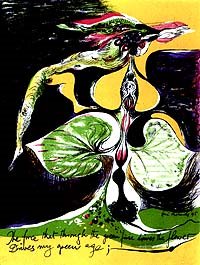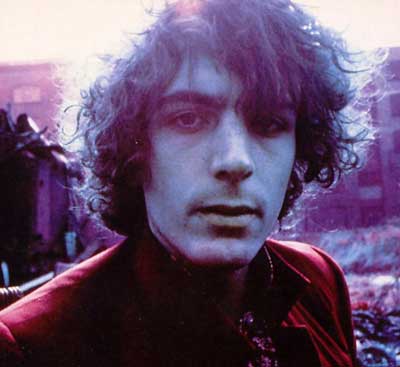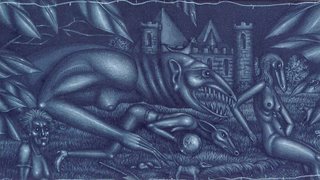 Cecil Collins & the Path of Beauty
Cecil Collins & the Path of Beauty
“All Art is divine fable expressing the Space-Time Mythology of the feelings of God”
In this piece I want to explore some of the themes emerging out of the visual, poetic and prose works of the great visionary artist Cecil Collins (1908-1989), and how they pertain to notions of depth, creativity, therapy and, what we might call ‘human purpose’. Rather like Blake before him, Collins brought his creative genius to bear on a spectrum of media – painting, poetry, prose, meditative reflections, sketches, iconography and teaching – and through diversity the unity of his consciousness found its truest expression.
In my own work, especially, though not exclusively, in poetry, I have been profoundly influenced by Collins’s example and at times a form of disembodied mentorship, ever since my microdot-peeled eyes (and I had thousands of them at that moment) gasped in overarching gratitude at the joy revealed in the heart of the image of ‘The Angel of the Flowing Light’, which clung to the wall of my college room at Oxford in poster-form. That experience in 1992, of the intense layering and feeling revealed through the eyes of the being whose side is ripped open in a river of light, and of the imaginal landscape behind the figure, come alive in unspeakably beautiful love, opened me to a fundamental truth, communicated in the unshakeable gnosis that death is not an end – if you like, death as I had imagined it to that moment, was no longer Real.
Ironic then, that I first want to quote from Collins’s meditations of the first half of the 1930s –
“Begun in the Age of Death
When the hard seeds cry out
For the Light”
Seeing through death does not prevent the process of dying – one still must die, drop the body as Eastern religions fondly say, still engage with the pain of separation and the often overwhelming waves of suffering that attachment to the stuff of transience brings humanity. However, awareness forged in the mysteries of the polyvalent moment, is not lost; see-feeling that death is not The End brings in the other mystery, that of continuity, timelessness manifest within time as a movement towards wholeness – for Collins, the Tradition. So as his 1930s world exhibited the first tendencies to machine-led death and horror in war, Collins reflected upon Light – the real medium in which he worked and created so delicately and with such passion. Light as we might encounter with it today feels a more care-worn vessel – stretched out by science into the helical dialectics of particle and wave, deployed by every patriarchal religion as the sky-god’s apocalypse-bringing thunderbolt (and now handily packaged in phallic missile form), co-opted to a New Age froth of false positivity and ‘spiritual bypassing’ through notions of ‘creating one’s own reality’ or else just plain lost in an exceedingly dark passage of human existence. Can we still apprehend some of Collins’s intention, as we the hard seeds cry out, blind to the truth that ‘All ecstasy is infinity’ ?

Here we approach some of the core of what Collins had to say. Since
“the Devil, by numerous various symbols and images
tries to bruise the God energy in me”
we begin to see how the various levels of cognition connect; there is God, (‘Eternal Mystery’, ‘Ghost’, ‘the only Self that really exists’, ‘God is Death’) and the energy God engenders in human beings and in life itself, there is the Devil (‘created to struggle with, and to purify us’) and there are the symbols and images inside of which the interactions occur. All of which relates also to time – since to exist is to exist within space-time. Here things get interesting, since ecstasy is infinity for Collins, it follows that ‘ecstasy is the self dissolved beyond poles’, in other words, to be ecstatic one must ‘dissolve’ into the vastness of infinity, the spaciousness behind God, free of the concerns of the over-attached ego (the Devil Inside, and not only inside Michael Hutchence). So we’re into the realms of the therapeutic – the modalities of healing and the dressing of life-wounds. Solve et Coagula, as the alchemists put it. Nowadays we tend to think of this as the world of Psychology, and indeed this is part of Psychology’s imperial project, insofar as it aspires to the ‘respectability’ of ‘hard’ science. Collins however, didn’t buy it for a moment:
“most of its (Psychology’s) conclusions are a vague arrogant naivety which will lead humanity into great misery – you cannot study the function of anything apart from its purpose, because apart from its purpose it has no function. Psychology does not know the purpose of Man, therefore how can it understand Man’s functions…”
He goes on to state very clearly that far from its stated intentions as herald of the ‘cure’ for the human condition
“Modern psychology is part of the expression of the illness of man”
and it is this way precisely because modern psychology has ignored the fundamental experience of holism in its rush for the reasonable (and we might add, with the benefit of generational insight, the lucrative, since the key application of psychology in our time lies in the interventions of advertising, marketing and sales in service to a ‘free’ and prevailing idea of Capital). The same is true in art(s) of all kind(s), even though from the imaginal place such debasements are meaningless. In relation to science Collins observes:
“the Artist apprehends the chemistry of existence while it lives
the scientist comprehends it when it is dead
this is life and death; poles both necessary to life”
However, what happens when ‘Man’ (Collins was Old School) as Artist loses the capacity to perceive the ‘chemistry of existence’ in living processes, and fixates instead on death? Presumably what we have now – a science predicated on profit margins and gross materialism, and no art to speak of – just an adolescence of the mind let loose on market forces and shock value; in short, a massive imbalance against life. At root
“All Art is ‘Let there be Light’
All Science is a searchlight upon a skeleton”
Because “Art is not talent, it is knowledge. Beauty is a form of cognition” and in that sense is not bound to sensation. Art therefore becomes at its heights, “the illusion by which we can understand Reality”. The key to this understanding is the “subjective imperfect world of symbols” – the ‘invisible need’ that is the fingerprint of that most un-postmodern quality – truth.
Not that Collins was down on sensation and feeling, quite the opposite – he was a painter of unqualified sensitivity and passion, and his writings express his immersion in the fecundity of earthly forms, femininity and the trans-gendered ambivalences of sacred sexuality (his figures and faces have a typical androgyny located in universe-widening eyes and long expressive noses, for example) he wrote
“What is called sensation or feeling is the imagination of the Real working within the limits of time” and that “Beauty is the life of Eternity in time”
Mystical pronouncements from an unschooled man, or penetration of the veils by a specially realised artist of loving-kindness, describing the Way we all, in our many ways, seek?
Going further into this thread, Collins observes (and this was in the early 1970s) that although we techno-moderns have a veneer of sophisticated complexity and depth we remain “absolute amateurs in the spiritual life”, and notes that for most of the ‘great’ civilizations of history that spiritual life has actually been the primary technology, giving rise to almost all that we think of or respond to as great in art, music, literature, architecture and so on. What has changed, he said, is what tends to happen in all civilizations as they approach their collapse – they lose their connection to eternity and begin a fixation on time and on endings. Hence for us
“the Artist, who was once employed to serve Man’s eternal destiny has nothing whatever to do in our civilization, other than to reflect our pathological preoccupation with time and lack of eternal purpose”.
This in turn gives rise to much ‘therapeutic expression’ masquerading as art, a product of an over-identification with time that Collins dates to the Renaissance in Europe – a movement from language to spectacle, laced up tightly in the ‘troubles of the local ego’. He spoke about the wound in imagination that such a condition creates, the ‘we can do what we want’ school of ‘thinking’, which is actually a kind of slavery, leaving the sufferer enmeshed in only their own ego-dramas and their ‘personal likes and dislikes’. It is precisely because this condition is trapped in the ‘small happiness’ of the small self, that we lose our most precious, and for Collins our most transcendently human capacity, that of
“Living for a goal higher than ourselves”
So it is that we flirt with the infinitely destructive forces of imagination, that have so created and can so annihilate, all the time stuck in words which leave us “correspondingly superficial” – just think of contemporary political rhetoric around climate change or The War on Terror ™ - we lack all ritual too, often scoffing at its forms, yet remaining cut off from the “kinetic participation in incomprehensible Reality” that it offers us. Perhaps the greatest wound though is to our aspirational nature – since
“identification with time gives us the illusion that there is such a thing as personal happiness”

whereas Tradition teaches that our Great Happiness is contingent upon fulfilling our cosmic purpose, as individuals, communities, species etc. So if art has stopped its enquiries into this cosmic field, and therapy is cut off from its artistic roots and healing life flow, all we have left is debased forms, the study of the minutiae of death, and a vastly proportioned delusion about our place and our path. We have become obsessed with looking – voyeurs of spectacle and reproduction (and Collins knew this without ever seeing ‘Big Brother’ or ‘I’m a Celebrity…’) and yet
“the prime need of our age is not looking, but contemplation. We live in a secondhand world of reproduction and our view of the world is becoming secondhand”
Since those words were written that second-handedness and the reification it hinges upon have only increased, and at a speed Collins could barely have comprehended. We are now, more than ever before, at the threshold of losing everything – civilization, the biosphere, life itself – all flowing from our minds, our self-creating imagery of dry dying, the ‘Arc of Dust’ as Collins called it:
“I saw the universe melt into a drop of venom and fall upon the ghost face of God
I saw acid tears fall upon things of eternal dimensions, and I wept at nothingness”
So where now? Is there any hope for the return of the anthropomorphic centre “wherein to focus life-experience” and create ‘sacramental form’? Is art’s illusion a spent vitality, now firing blanks? Have we still not heard Goethe (as Collins certainly had) whispering ‘An artist is attached to his age by his weakness, not by his strength’?
We need the ‘contemplation of the wrought image’ that the artist opens, or the therapist handles, or the politician is inspired by to ‘orientate us towards Reality’ – to honour our invisible need for truth in our bodies, as well as our minds, our hearts as well as our genitals, our instinct to give, as well as our conditioning to take. Only then can we hope to wrap ourselves in the contemplation of ecstasy and participate in life as bold mystery rather than seductive sense-prison or consensus death camp. The last word, the uber-question of Rubedo perhaps, is Cecil’s –
“can a happiness be won from the terrifying ugliness of life by a subtle spiritual war?”
kh
10.7.06
IMAGES: The Angel of the Flowing Light (1968), The Poet (1941) & The Sleeping Fool (1943) all by Cecil Collins.
Quotations from: Cecil Collins Meditations, Poems, Pages from a Sketchbook (1997, ed. Brian Keeble)


























